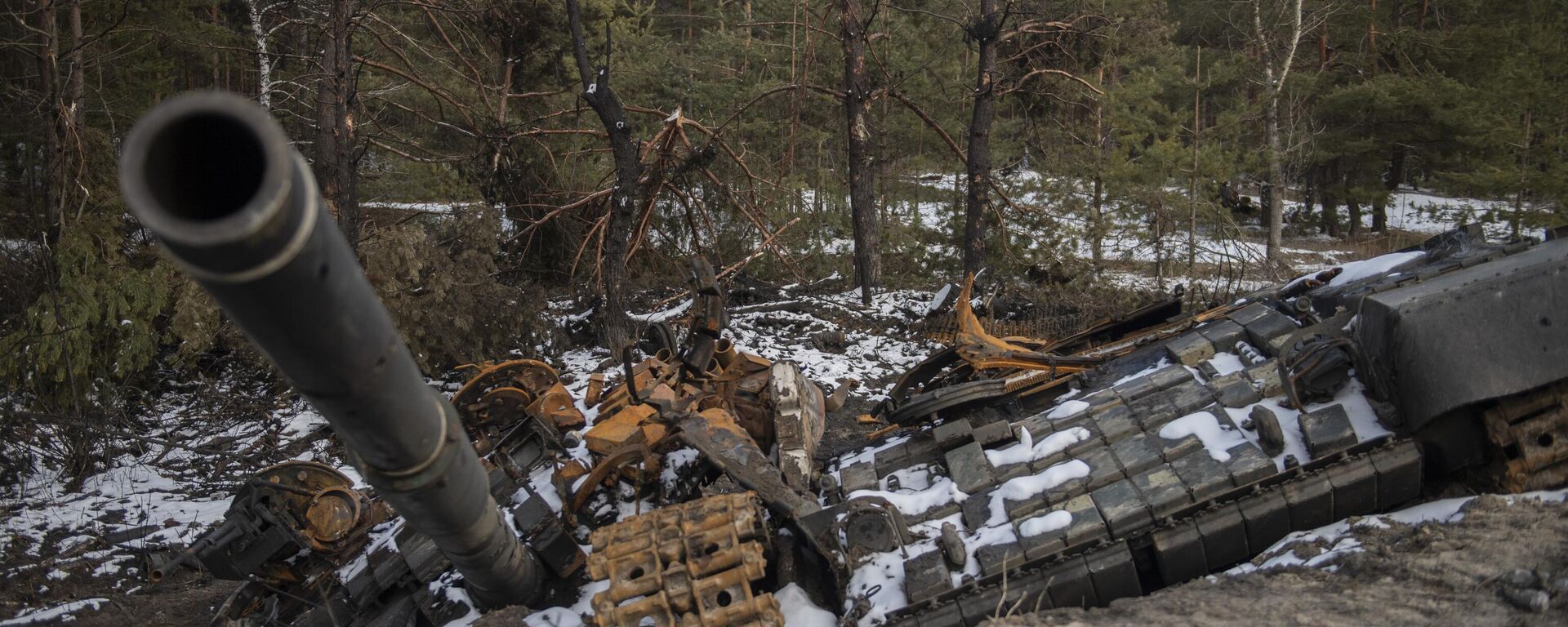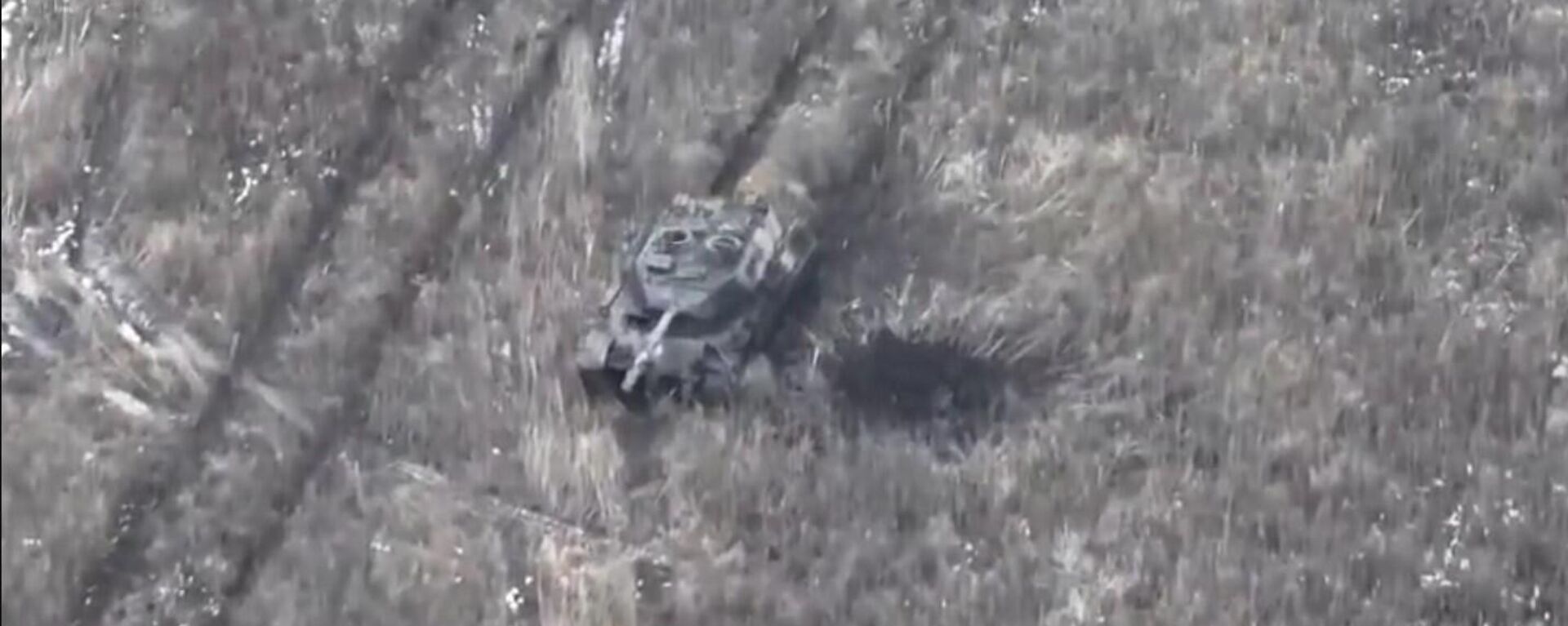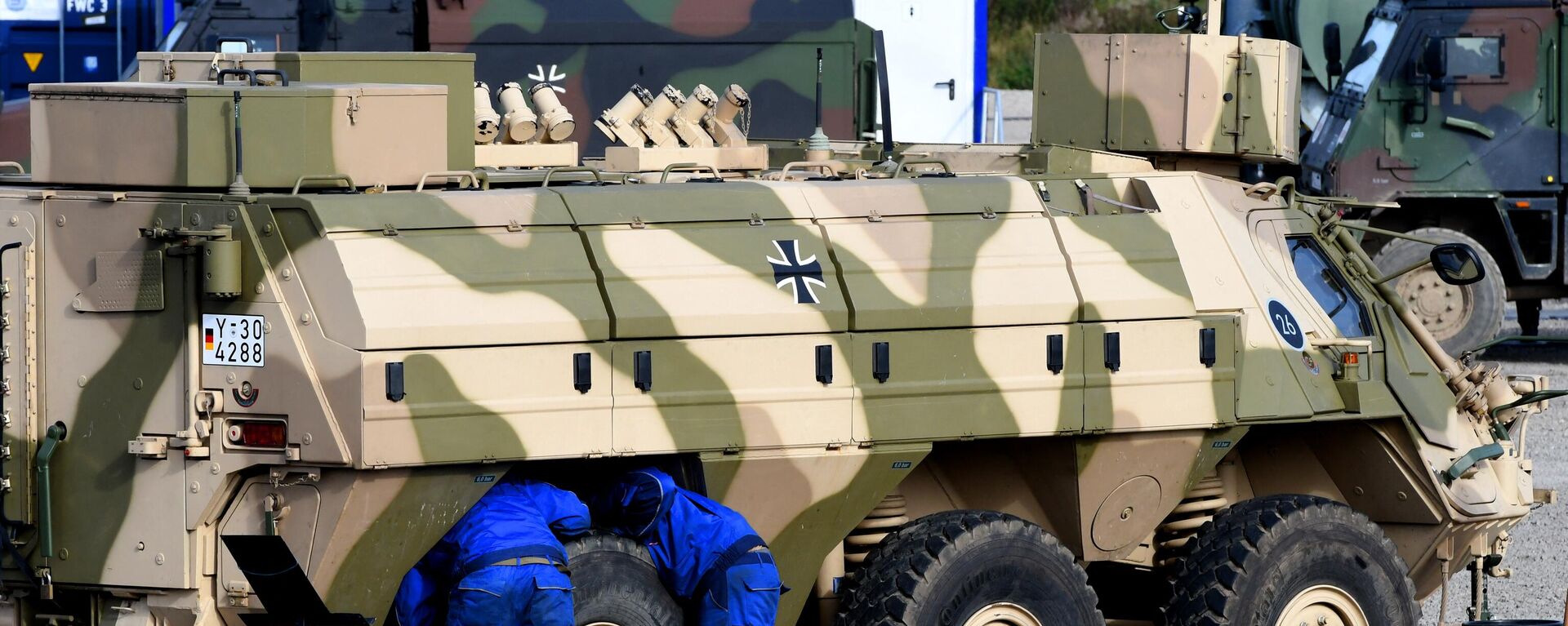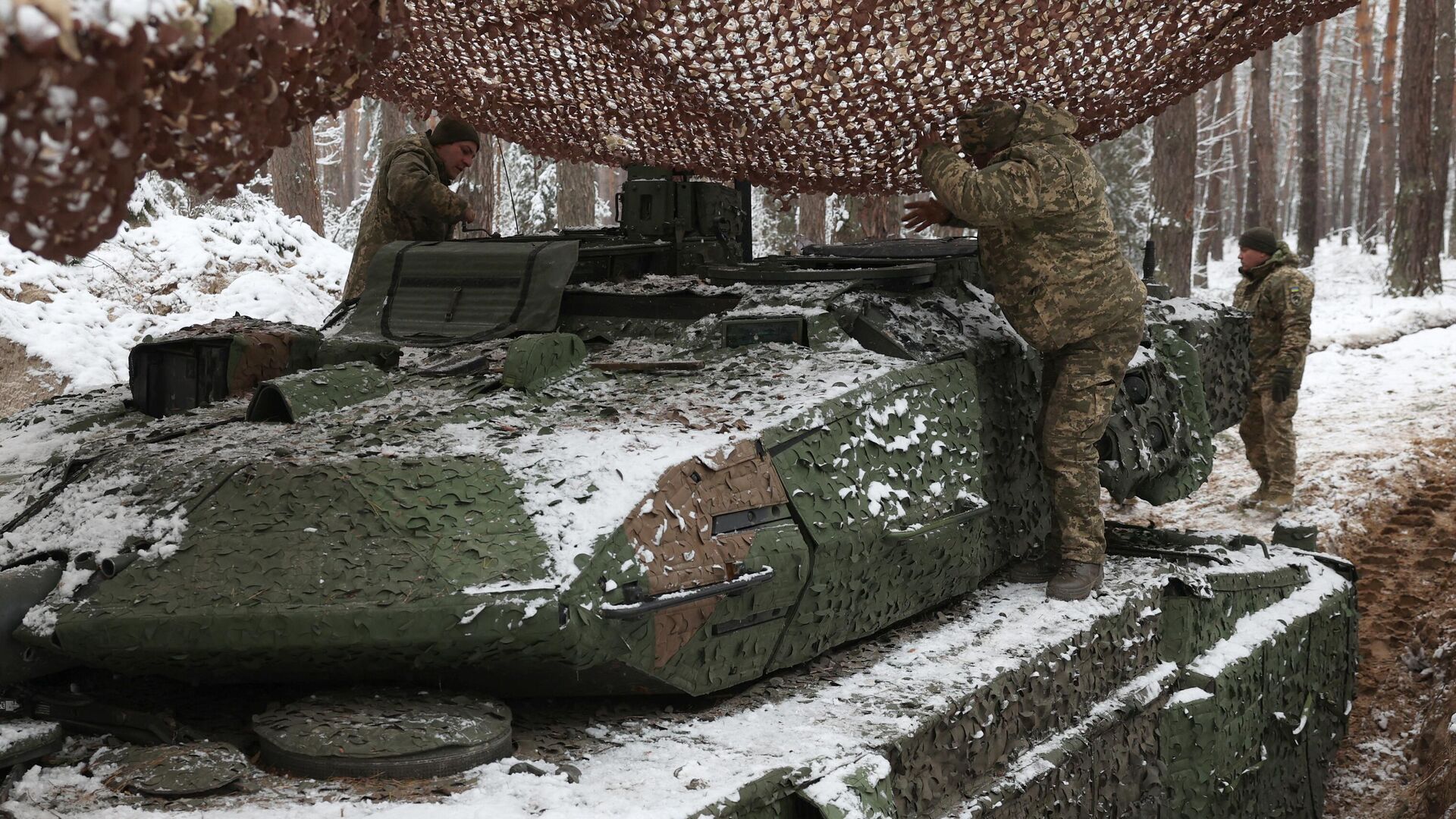https://sputnikglobe.com/20231207/counteroffensive-in-reverse-why-ukraine-is-using-nato-tanks-as-stationary-artillery-1115453051.html
Counteroffensive in Reverse? Why Ukraine is Using NATO Tanks as Stationary Artillery
Counteroffensive in Reverse? Why Ukraine is Using NATO Tanks as Stationary Artillery
Sputnik International
Volodymyr Zelensky announced plans last week to turn Ukraine into a fortress, tacitly admitting that Kiev’s counteroffensive had failed. Now Ukraine plans to use its NATO-gifted armor as emplaced turrets.
2023-12-07T13:36+0000
2023-12-07T13:36+0000
2023-12-07T15:42+0000
russia's special operation in ukraine
military & intelligence
volodymyr zelensky
viktor litovkin
ukraine
russia
kiev
nato
russian army
https://cdn1.img.sputnikglobe.com/img/07e7/0c/07/1115452727_0:170:3040:1880_1920x0_80_0_0_c31ccf2ea689329f38da0def956b9002.jpg
Ukraine has begun using at least some of its German-made Leopard-series main battle tanks as makeshift artillery. Troops have begun digging the heavy armor deep into the ground in a 'hull-down' position and deploying it to target Russian infantry and infrastructure.“In other words, it’s not being used in the same way as during the counteroffensive,” a 25-year-old Ukrainian grunt named Ruslan told a Western news agency of the strategy — in a piece seemingly pointing the finger at NATO for not giving Ukraine’s military more of their advanced main battle tanks.“It’s more efficient,” a company commander told the outlet. “The front has calmed down a little. Winter is coming. We won’t be advancing in force,” he claimed.“It wasn’t really planned this way,” a separate German media article insisted. “Leopard 2A6 tanks delivered by Germany are being used to prevent the east of the country from falling further under Russian control,” the outlet reported, to counter Russia’s steady advance through the Kharkov region north of the defensive lines Ukrainian forces failed to crack this summer.Ukrainian President Volodymyr Zelensky announced a shift in Ukraine’s military strategy last week. He stressed the lack of resources for building fortifications across the country including in Ukrainian-occupied areas of Donetsk, Zaporozhye, and Kherson regions, as well as Kharkov, Sumy, Chernigov, Kiev, Rovno and Volyn.Last week the politician admitted to US media that Ukraine was in a “new phase of war,” complaining that he was dissatisfied with the west's failure to provide all the arms he wanted for Ukraine’s summer counteroffensive.“We wanted faster results. From that perspective, unfortunately, we did not achieve the desired results. And this is a fact,” Zelensky said. That resembled a tacit admission that General Valery Zaluzhny his top military commander was correct last month when he stated that the conflict had become a “stalemate,” that there would be no “deep and beautiful breakthrough” and that tactics in “NATO’s textbooks” had failed.Kiev’s summer counteroffensive reached the sixth-month mark on Monday. Ukrainian forces have captured just a few dozen square kilometers of territory in front of Russia’s defensive lines, but failed to pierce them. Russia’s defense ministry recently estimated the cost to Ukraine of those meagre gains at more than 125,000 troops and some 16,000 pieces of weaponry.Among the lost weapons were dozens of Leopard tanks delivered by Germany and other NATO countries, including older Leopard 1 models and the newest variants of the Leopard 2, Germany’s most modern main battle tank.What Does Using Tanks for Defense Say About Kiev’s Strategy?The tactic of using tanks for defensive purposes serves as another confirmation of the counteroffensive’s failure, and is unlikely to alter Russia’s overall strategy in any significant way, says retired Russian Army colonel and veteran military analyst Viktor Litovkin.“Defense is when the tank is buried in the ground, with only its tower sticking out above it, serving as a weapon that fires at attackers and is well protected, including by the ground,” Litovkin told Sputnik. “But since the Leopard tanks delivered to Ukraine were generally not the newest ones, they have relatively weak armor and guns which are not very powerful for defense.”The stationary tank strategy “will not help Ukraine in any way in military operations against Russia,” the observer said. “We will continue to strike them. Just as aircraft bombed these Ukrainian positions, they’ll continue to bomb them. A tank is, to put it mildly, a tin box. A strike from above by any bomb or cumulative projectile and that’s it – no more tank. The tank’s crew generally has difficulties seeing what’s happening around them. They need additional ‘eyes’ in the form of helicopters or unmanned aerial vehicles, so that they can see what’s happening around them.”Leopards are among the handful of modern Western main battle tank designs delivered to Ukraine ahead of its counteroffensive earlier this year, which also included 14 British-made Challenger 2 tanks and 31 American M1 Abrams — the latter only arriving after it became clear that the counteroffensive had stalled.At the twilight of the Cold War in the 1980s and early 1990s, these chunky, electronics-filled Western tank designs were hailed as the perfect killers of Warsaw Pact armor. Such mythmaking continued all the way into the recent present, with Leopard maker Rheinmetall CEO Armin Papperger boasting in January that a Leopard 2-equipped army “can break through enemy lines and put an end to a long period of trench warfare,” and that “with the Leopard, soldiers can advance dozens of kilometers at a time.”Less than a year later, the German defense giant has been forced to eat its director’s words with a series of reports going back to the summer indicating that Ukraine’s commanders were hesitant to deploy their heavy armor even at the height of the counteroffensive out of fears that they would be lost to Russian missiles, long-range artillery, anti-tank mines and drones.
https://sputnikglobe.com/20231202/youre-doing-it-wrong-ukraines-former-top-general-lambasts-failed-counteroffensive-1115346992.html
https://sputnikglobe.com/20231129/ukraine-lost-first-leopard-1a5-tank-just-in-several-weeks---reports-1115273516.html
https://sputnikglobe.com/20231202/why-rheinmetalls-proposed-armored-vehicle-production-in-ukraine-is-infeasible-1115346238.html
ukraine
russia
kiev
Sputnik International
feedback@sputniknews.com
+74956456601
MIA „Rossiya Segodnya“
2023
News
en_EN
Sputnik International
feedback@sputniknews.com
+74956456601
MIA „Rossiya Segodnya“
Sputnik International
feedback@sputniknews.com
+74956456601
MIA „Rossiya Segodnya“
ukraine, counteroffensive, tanks, dug in, dig in, artillery, entrench, russia, leopard, tank, mbt, main battle tank, armor
ukraine, counteroffensive, tanks, dug in, dig in, artillery, entrench, russia, leopard, tank, mbt, main battle tank, armor
Counteroffensive in Reverse? Why Ukraine is Using NATO Tanks as Stationary Artillery
13:36 GMT 07.12.2023 (Updated: 15:42 GMT 07.12.2023) Volodymyr Zelensky announced plans last week to turn Ukraine into a fortress, tacitly admitting that Kiev’s counteroffensive had failed after a month of arguing with his top commander’s assessment. In line with that strategic shift, Ukraine plans to give its NATO-gifted armor with a new role as emplaced turrets.
Ukraine has begun using at least some of its German-made Leopard-series main battle tanks as makeshift artillery.
Troops have begun digging the heavy armor deep into the ground in a 'hull-down' position and deploying it to target Russian infantry and infrastructure.
“In other words, it’s not being used in the same way as during the counteroffensive,” a 25-year-old Ukrainian grunt named Ruslan
told a Western news agency of the strategy — in a piece seemingly pointing the finger at NATO for not giving Ukraine’s military more of their advanced main battle tanks.
Leopards are “very effective, but to carry out large-scale offensives, you need more,” the soldier complained, estimating that Kiev would have needed at least 150 of the tanks to put a dent in Russian lines.
“It’s more efficient,” a company commander told the outlet. “The front has calmed down a little. Winter is coming. We won’t be advancing in force,” he claimed.
“It wasn’t really planned this way,” a separate German media article insisted. “Leopard 2A6 tanks delivered by Germany are being used to prevent the east of the country from falling further under Russian control,” the outlet
reported, to counter Russia’s steady advance through the Kharkov region north of the defensive lines Ukrainian forces failed to crack this summer.

2 December 2023, 16:44 GMT
Ukrainian President Volodymyr Zelensky
announced a shift in Ukraine’s military strategy last week. He stressed the lack of resources for building fortifications across the country including in Ukrainian-occupied areas of Donetsk, Zaporozhye, and Kherson regions, as well as Kharkov, Sumy, Chernigov, Kiev, Rovno and Volyn.
“We discussed the mobilization of resources, the motivation of private business in this work, and financing. The priority is obvious,” Zelensky said.
Last week the politician admitted to US media that Ukraine was in a “new phase of war,” complaining that he was dissatisfied with the west's failure to provide all the arms he wanted for Ukraine’s summer counteroffensive.
“We wanted faster results. From that perspective, unfortunately, we did not achieve the desired results. And this is a fact,” Zelensky said. That resembled a tacit admission that General Valery Zaluzhny his top military commander was correct last month when he stated that the conflict had become a “stalemate,” that there would be no “deep and beautiful breakthrough” and that tactics in “NATO’s textbooks” had failed.
Kiev’s summer counteroffensive reached the sixth-month mark on Monday. Ukrainian forces have captured just a few dozen square kilometers of territory in front of Russia’s defensive lines, but failed to pierce them. Russia’s defense ministry
recently estimated the cost to Ukraine of those meagre gains at more than 125,000 troops and some 16,000 pieces of weaponry.
Among the lost weapons were dozens of Leopard tanks delivered by Germany and other NATO countries, including older Leopard 1 models and the newest variants of the Leopard 2, Germany’s most modern main battle tank.

29 November 2023, 05:36 GMT
What Does Using Tanks for Defense Say About Kiev’s Strategy?
The tactic of using tanks for defensive purposes serves as another confirmation of the counteroffensive’s failure, and is unlikely to alter Russia’s overall strategy in any significant way, says retired Russian Army colonel and veteran military analyst Viktor Litovkin.
“Defense is when the tank is buried in the ground, with only its tower sticking out above it, serving as a weapon that fires at attackers and is well protected, including by the ground,” Litovkin told Sputnik. “But since the Leopard tanks delivered to Ukraine were generally not the newest ones, they have relatively weak armor and guns which are not very powerful for defense.”
“Now, Ukraine is moving to so-called positional defense – they’ve announced it. But this does not change anything on the battlefield. They have no one and nothing left to fight with, so the morale of the Ukrainian army is very low. Therefore, they surrender there as entire units, if they can manage to avoid being shot in the back,” the observer said, referring to the ultranationalist ‘blocking battalions’ set up in some rear areas behind Ukrainian lines reported on extensively by Ukrainian PoWs.
The stationary tank strategy “will not help Ukraine in any way in military operations against Russia,” the observer said. “We will continue to strike them. Just as aircraft bombed these Ukrainian positions, they’ll continue to bomb them. A tank is, to put it mildly, a tin box. A strike from above by any bomb or cumulative projectile and that’s it – no more tank. The tank’s crew generally has difficulties seeing what’s happening around them. They need additional ‘eyes’ in the form of helicopters or unmanned aerial vehicles, so that they can see what’s happening around them.”
Leopards are among the handful of modern Western main battle tank designs delivered to Ukraine ahead of its counteroffensive earlier this year, which also included 14 British-made Challenger 2 tanks and 31 American M1 Abrams — the latter only arriving after it became clear that the counteroffensive had stalled.
At the twilight of the Cold War in the 1980s and early 1990s, these chunky, electronics-filled Western tank designs were hailed as the perfect killers of Warsaw Pact armor. Such mythmaking continued all the way into the recent present, with Leopard maker Rheinmetall CEO Armin Papperger
boasting in January that a Leopard 2-equipped army “can break through enemy lines and put an end to a long period of trench warfare,” and that “with the Leopard, soldiers can advance dozens of kilometers at a time.”
Less than a year later, the German defense giant has been forced to eat its director’s words with a series of reports going back to the summer indicating that Ukraine’s commanders were
hesitant to deploy their heavy armor even at the height of the counteroffensive
out of fears that they would be lost to Russian missiles, long-range artillery, anti-tank mines and drones.

2 December 2023, 14:39 GMT





